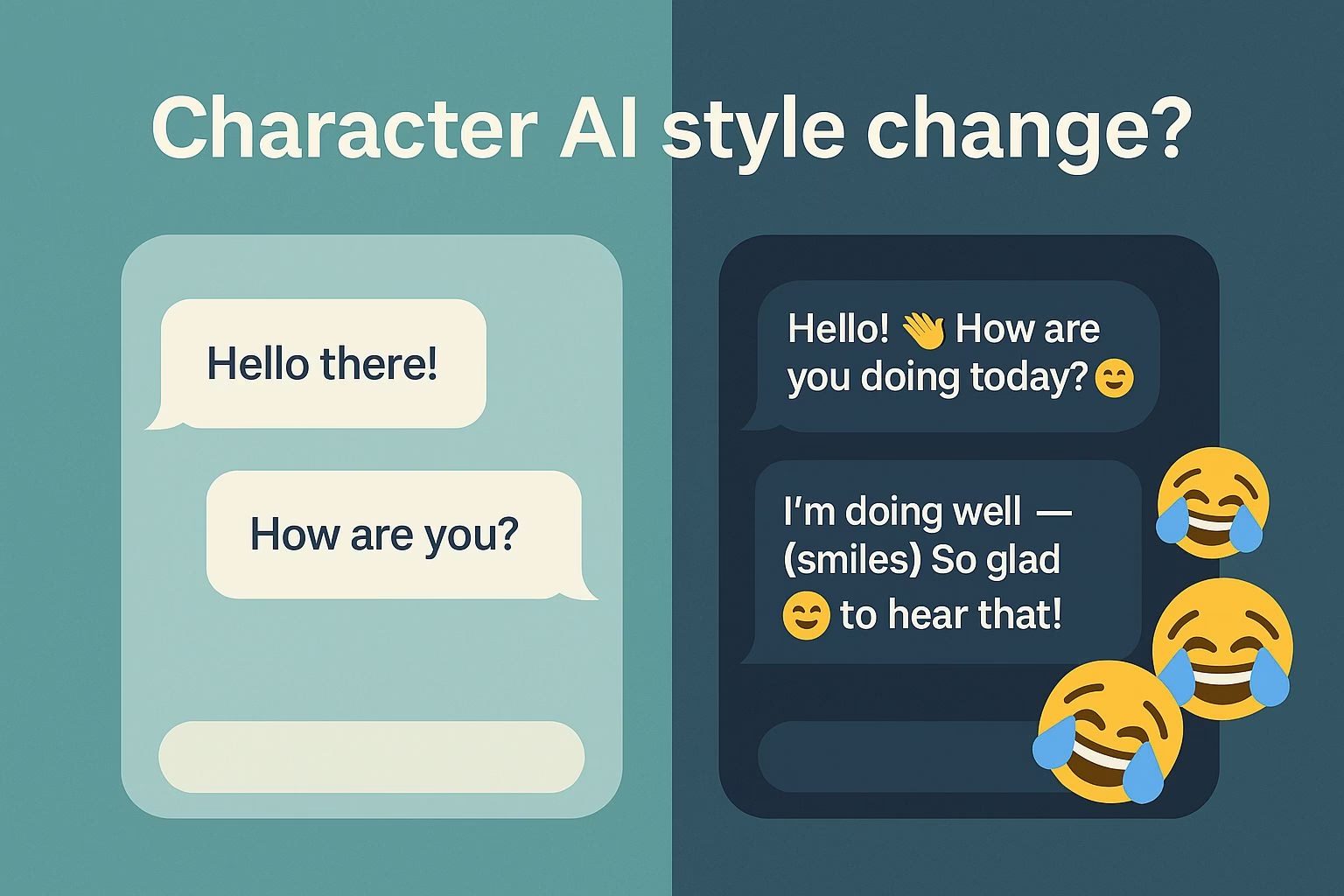Why did Character AI suddenly change its writing style
Quick takeaways
- What changed: bots shifted to brackets, bold actions, many emojis, and longer rambly replies.
- Likely cause: a backend tweak or bug with uneven rollout across accounts.
- Who is affected: reports span Roar and Pipsqueak, but not everyone sees it.
- Quick fixes: switch styles temporarily, set “plain text only” rules in your prompt, and open a support ticket with examples.
- What to request: a style toggle, clear communication, or a rollback if unintended.
Many users have noticed something strange with Character AI bots. Chats that once read smoothly in simple text now look very different.
Messages are filled with bold actions, brackets, and even strings of emojis. What used to feel like natural dialogue now comes across as cluttered or confusing.
The change has sparked frustration among people who preferred the old format. Bots that once wrote like fanfiction characters suddenly switched to new grammar rules and overlong replies.
Some even started narrating actions in ways that felt out of place, leaving regular users wondering what went wrong.
Part of the confusion comes from the fact that it happened without warning. One day the text looked normal, the next day it was full of styles nobody asked for.
Different models like Pipsqueak and Roar seem to be blending behaviors, making it harder for users to stick with a style they enjoy.
There’s also debate on whether this is a bug or a deliberate tweak. Some think developers pushed a quiet update to how bots handle text.
Others believe it’s a glitch that made models act in strange ways.
Either way, the lack of communication has left people annoyed, and many are calling on the devs to fix it.
Why are Character AI bots using brackets and emojis now
The most common complaint from users is the sudden shift to brackets, bold text, and emoji-heavy responses.
Before, many bots stuck to plain narrative styles that resembled fanfiction or casual storytelling. Now, they sprinkle actions in parentheses, add emojis after nearly every sentence, and overuse formatting that feels artificial.
This change makes conversations harder to follow. Instead of immersing readers in dialogue, the formatting breaks the flow.
Some even mistake parentheses for out-of-character commentary. For users who enjoyed clean text roleplay, the experience now feels cluttered and less authentic.
Different models appear to contribute to the inconsistency.
For example, those who use Roar noticed it began mimicking traits of Pipsqueak, a style that narrates actions differently.
People switching between models found no way to escape the changes, since the problem carried across multiple bots. That left many thinking the issue is deeper than a single style preference.
It’s possible this is tied to recent backend tweaks. AI companies often adjust models for readability or “expressiveness,” but what feels like an upgrade in theory may not land well in practice.
In this case, the overuse of symbols and emojis seems like a downgrade for those who preferred a straightforward text style.
Is this a bug or a permanent change?
A big question is whether these changes are intentional. Some users think developers rolled out new defaults without notice.
Others argue it must be a bug, because the quality of responses dropped too sharply for it to be deliberate. Bots ramble, repeat themselves, and use formatting that nobody requested.
The lack of clarity from Character AI’s team fuels the frustration. If it’s an experiment, users want the option to opt out.
If it’s a bug, they want reassurance that it will be fixed quickly. Without updates from the developers, the community is left to speculate.
Reports also suggest the issue isn’t universal. Some people still get normal responses, while others see the new writing quirks across all chats.
That uneven rollout points more toward a bug or a test running in limited batches. Either way, it disrupts the experience for those who expected consistency from their long-term bots.
Until developers clarify, the safest guess is that this is an unintended side effect of a system-wide change.
Whether it’s a model merge, a formatting update, or a style experiment, the silence only makes it worse. For now, users can only wait or try swapping styles to see if it resets their chat flow.
What can users do to fix the style change
Right now, there’s no official fix, but some users have shared workarounds. Switching between models like Roar and Pipsqueak sometimes resets the writing style.
Others suggest picking a different style for a while, letting it “settle,” and then returning to the one you prefer. While not guaranteed, it helped a few people bring back more natural text.
Another option is to send feedback directly to the developers. If enough people open support tickets, the team will have clearer evidence that this isn’t just a niche complaint.
Reporting examples of how the bots changed their writing could speed up any rollback or adjustment.
Some users also experiment with prompts to control the bot’s output.
Setting rules such as “write only in plain text without emojis or brackets” sometimes helps the model stick to the old behavior. It doesn’t always work, but it gives more control than waiting for an official fix.
The bigger issue is that these changes should be optional.
Users want to pick their style, not have it forced on them. Until the developers respond, the best approach is trial and error with settings, styles, and prompts.
What this means for long-term Character AI fans
For people who’ve invested months into their chats, sudden shifts like this feel discouraging. Bots that once carried a consistent personality now act in ways that break immersion.
Stories lose continuity, and characters stop sounding like themselves. That undermines the main reason many people use Character AI in the first place.
The risk is that users lose trust. If a favorite bot changes without warning, people may start looking for alternatives that give more control over style.
Options like Candy AI or CrushOn AI, which emphasize flexibility in how chats are handled, become more appealing in moments like this.
It also raises questions about communication between developers and the community. Changes rolled out in silence create confusion and frustration.
Even if the intent was to improve expression, not explaining it leaves users feeling ignored.
For long-time fans, the hope is that Character AI will listen and provide either a fix or a toggle for writing style.
Without that, the bond people build with their bots risks being disrupted every time the system changes unexpectedly.

